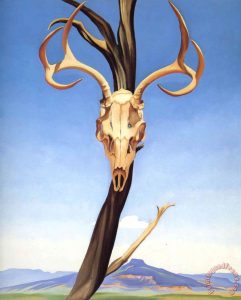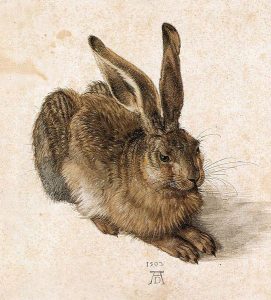
Deers Skull with Pedernal Painting by Georgia O’Keeffe
Deer’s Skull with Pedernal, Georgia O’Keeffe, Oil on Canvas, 36 x 30 ⅛ in, 1936
O’Keeffe was a prolific American Southwestern artist in the early twentieth century who is known for her rich interpretations of surrealistic landscape and still life. In Deer’s Skull with Pedernal, there is tension portrayed in the contrasting color scheme between the foreground and the background. Her forms tend to be naturalistic, following organic threads yet allowing geometric highlights when needed in order to represent her figures realistically. The minimalist gradient of royal blue that comprises most of the background lends focus to the forms gathering at the bottom on the piece and objects in the foreground. The Pedernal, which refers to the butte in the background, had specific personal meaning to O’Keeffe due to the fact that it was near her place of residence near Santa Fe, New Mexico. The artist has a tendency to have a strong personal connection to her work, depicting her own internal experience with her environment. Balance and harmony are key elements in this piece, with the thin, vertical foreground objects seemingly splitting the composition into two almost equal parts. O’Keeffe chose to render a deer skull instead of a live deer, and a dead pinon tree instead of vibrant, living specimen both in rich, neutral tones. These deliberate acts, coupled with the vibrant, stylized color scheme of the landscape behind it, imply commentary on the balance between life and death.

Young Hare, Albrecht Dürer, Watercolor and Bodycolour on Cream Wash, 9.9 x 8.9 in, 1502
Albrecht Dürer was highly influential painter, engraver and mathematician of the classic German Renaissance during the late fourteenth and early fifteenth century. Before the seventeenth century, animal studies were not recognized as an official genre of art, therefore Dürer’s realistic representation of a hare as it is without any implication to religiosity or symbolism was considered avant garde for the time period. The depiction of the hare is almost hyperrealistic, with precise attention to detail to anatomy, fur texture, and positioning. The background is minimalist, which draws the viewer’s attention solely to the form depicted in the painting. The form is created with delicate layers of indirect painting coupled with soft textured brush strokes, which give it dimension and depth. The color scheme spans over an array of both soft and rich neutrals, lending itself to the colors a physical specimen of rabbit would display. In this study, the audience is able to pay attention to the subtle detail that a real hare would have, which allows them to reach a conclusion of tangibility and organic materiality. Unlike O’Keeffe, Dürer’s representation of form in subjective, unbiased, and lacks personal motive for the piece. This helps the audience understand his images through a broadened scope, without interruption of bias or subliminal meaning. Dürer was interested in the intangible meaning of nature itself, without the impact of humankind. This piece is an investigation of natural forces outside of human control, and how they can be viewed from a perspective devoid of humanistic symbolic interpretation.

Leave a Reply